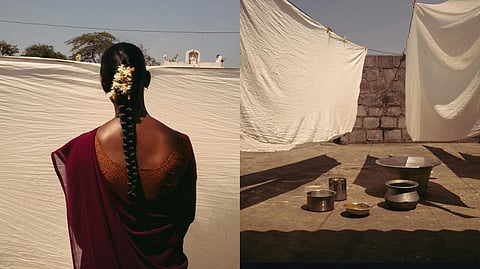
- HOMEGROWN WORLD
- #HGCREATORS
- #HGEXPLORE
- #HGVOICES
- #HGSHOP
- CAREERS
- ABOUT US
- CONTACT US

The origins of Kalamkari can be traced back to over 3000 years ago when bamboo pens were used to print fabrics. This craft was also partially responsible for the series of events that led to India losing its independence. One of the two distinctive styles of Kalamkari in India, the Srikalahasti style, wherein the ‘kalam’ or pen is used for freehand drawing of the subject and filling in the colours, is entirely hand worked. This style flowered around temples and their patronage and so had an almost religious identity - with scrolls, temple hangings, chariot banners and the like, depicting deities and scenes taken from the Hindu mythological classics. In a photoseries by Gorkey Patwal, the process behind this craft is documented at the very place the style is named after. Commissioned by Archana Jaju for a workshop they held in Tirupati, the photoseries takes us behind the scenes of this ancient textile tradition.
Kalamkari, meaning ‘pen work’ in Persian, epitomizes a meticulous process where artisans hand-carve intricate designs onto wooden blocks. These blocks, first sketched on paper, are transformed through skilled hands into tools that imprint patterns on to pure cotton fabrics. The journey begins with treating the cloth in a blend of water and cow dung, a traditional method to bleach and prepare the fabric by removing starches. Sun-drying follows, preparing the canvas for the next step — treating it with a blend of myrobalan and buffalo milk. This natural concoction not only sets the fabric's tone but also acts as a fixative for the dyes to come.
Each piece undergoes several rounds of printing, starting with outlines in shades like black or red, before embracing hues like red, blue, yellow, green, or black. The river becomes a pivotal part of the process, washing away excess dye, after which the fabric is sundried, ready for the next intricate layer of prints. Intersecting artisanal skill with natural elements, this process culminates in fabrics that resonate with both handicrafts and heritage.
Archana Jaju, fueled by a lifelong passion for fashion and deep-rooted ties to India's textile heritage, embarked on her creative journey decades ago. Her eponymous brand, born in 1996, speaks to her relentless pursuit of merging tradition with contemporary fashion sensibilities. Collaborating closely with artisans nationwide, Archana curates pieces that celebrate India's rich cultural diversity and craftsmanship.
At the heart of her brand lies a commitment to sustainability and comfort, crafting luxurious fabrics that embrace the wearer in elegance and ease. Each creation reflects not just a design but a narrative that’s also a homage to India's skilled artisans and their craftsmanship.
Through this captivating photoseries, Gorkey's lens captures a story of heritage, resilience, and creativity. It's a visual feast that beckons viewers to appreciate the intricate details and the human stories behind each piece. As Archana Jaju continues to redefine luxury through her brand, she not only preserves India's textile traditions but also empowers artisans to thrive in a global marketplace. This collaborative photoseries is a reminder that when rooted in heritage and crafted with passion, fashion can become a canvas for stories that endure across generations.
If you enjoyed reading this, here's more from Homegrown:
Farha Alam Blurs The Lines Of Visual Art To Create Stunning Multifaceted Artworks
Aranya Gupta’s Art Is A Contrast Of Vibrant Landscapes & Distorted Human Anatomy
Read A New Photobook Exploring The Sublime Artistry Of Indian Master Potter Ramu Velar
